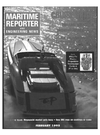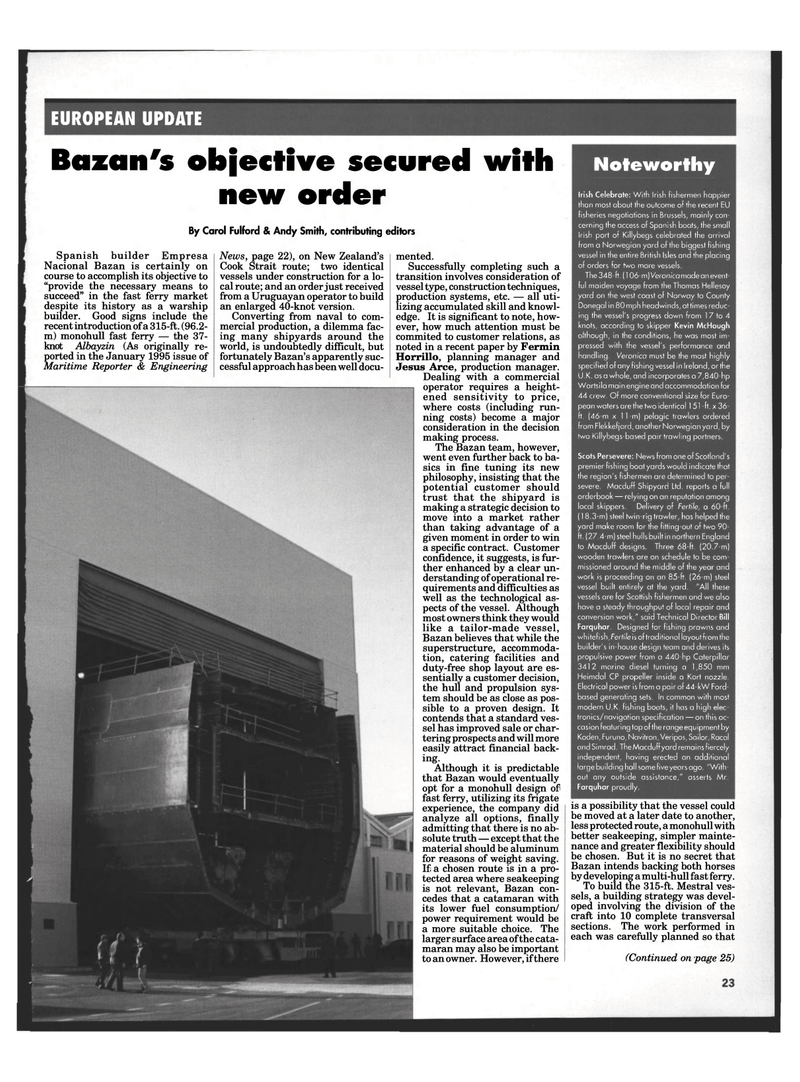
Page 21: of Maritime Reporter Magazine (February 1995)
Read this page in Pdf, Flash or Html5 edition of February 1995 Maritime Reporter Magazine
EUROPEAN UPDATE
Bazan's objective secured with new order
Noteworthy
Irish Celebrate: With Irish fishermen happier than most about the outcome of the recent EU fisheries negotiations in Brussels, mainly con- cerning the access of Spanish boats, the small
Irish port of Killybegs celebrated the arrival from a Norwegian yard of the biggest fishing vessel in the entire British Isles and the placing of orders for two more vessels.
The348-ft. (106-m)Veron/camade an event- ful maiden voyage from the Thomas Hellesoy yard on the west coast of Norway to County
Donegal in 80 mph headwinds, attimes reduc- ing the vessel's progress down from 1 7 to 4 knots, according to skipper Kevin McHough although, in the conditions, he was most im- pressed with the vessel's performance and handling. Veronica must be the most highly specified of any fishing vessel in Ireland, or the
U.K. as a whole, and incorporates a 7,840-hp
Wartsila main engine and accommodation for 44 crew. Of more conventional size for Euro- pean waters are the two identical 151 -ft. x 36- ft. (46-m x 1 1 -m) pelagic trawlers ordered from Flekkefjord, another Norwegian yard, by two Killybegs-based pair trawling partners.
Scots Persevere: News from one of Scotland's premier fishing boatyards would indicate that the region's fishermen are determined to per- severe. Macduff Shipyard Ltd. reports a full orderbook — relying on an reputation among local skippers. Delivery of Fertile, a 60-ft. (18.3-m) steel twin-rig trawler, has helped the yard make room for the fitting-out of two 90- ft. (27.4-m) steel hulls built in northern England to Macduff designs. Three 68-ft. (20.7-m) wooden trawlers are on schedule to be com- missioned around the middle of the year and work is proceeding on an 85-ft. (26-m) steel vessel built entirely at the yard. "All these vessels are for Scottish fishermen and we also have a steady throughput of local repair and conversion work," said Technical Director Bill
Farquhar. Designed for fishing prawns and whitefish, Fertile is of traditional layout from the builder's in-house design team and derives its propulsive power from a 440-hp Caterpillar 3412 marine diesel turning a 1,850 mm
Heimdal CP propeller inside a Kort nozzle.
Electrical power is from a pair of 44-kW Ford- based generating sets. In common with most modern U.K. fishing boats, it has a high elec- tronics/navigation specification — on this oc- casion featuring top of the range equipment by
Koden, Furuno, Navitron, Veripos, Sailor, Racal and Simrad. The Macduff yard remains fiercely independent, having erected an additional large building hall some five years ago. "With out any outside assistance," asserts Mr.
Farquhar proudly. is a possibility that the vessel could be moved at a later date to another, less protected route, a monohull with better seakeeping, simpler mainte- nance and greater flexibility should be chosen. But it is no secret that
Bazan intends backing both horses by developing a multi-hull fast ferry.
To build the 315-ft. Mestral ves- sels, a building strategy was devel- oped involving the division of the craft into 10 complete transversal sections. The work performed in each was carefully planned so that (Continued on page 25) mented.
Successfully completing such a transition involves consideration of vessel type, construction techniques, production systems, etc. — all uti- lizing accumulated skill and knowl- edge. It is significant to note, how- ever, how much attention must be commited to customer relations, as noted in a recent paper by Fermin
Horrillo, planning manager and
Jesus Arce, production manager.
Dealing with a commercial operator requires a height- ened sensitivity to price, where costs (including run- ning costs) become a major consideration in the decision making process.
The Bazan team, however, went even further back to ba- sics in fine tuning its new philosophy, insisting that the potential customer should trust that the shipyard is making a strategic decision to move into a market rather than taking advantage of a given moment in order to win a specific contract. Customer confidence, it suggests, is fur- ther enhanced by a clear un- derstanding of operational re- quirements and difficulties as well as the technological as- pects of the vessel. Although most owners think they would like a tailor-made vessel,
Bazan believes that while the superstructure, accommoda- tion, catering facilities and duty-free shop layout are es- sentially a customer decision, the hull and propulsion sys- tem should be as close as pos- sible to a proven design. It contends that a standard ves- sel has improved sale or char- tering prospects and will more easily attract financial back- ing.
Although it is predictable that Bazan would eventually opt for a monohull design of fast ferry, utilizing its frigate experience, the company did analyze all options, finally admitting that there is no ab- solute truth—except that the material should be aluminum for reasons of weight saving.
If a chosen route is in a pro- tected area where seakeeping is not relevant, Bazan con- cedes that a catamaran with its lower fuel consumption/ power requirement would be a more suitable choice. The larger surface area of the cata- maran may also be important to an owner. However, if there
By Carol Fulford & Andy Smith, contributing editors
Spanish builder Empresa
Nacional Bazan is certainly on course to accomplish its objective to "provide the necessary means to succeed" in the fast ferry market despite its history as a warship builder. Good signs include the recent introduction of a 315-ft. (96.2- m) monohull fast ferry — the 37- knot Albayzin (As originally re- ported in the January 1995 issue of
Maritime Reporter & Engineering
News, page 22), on New Zealand's
Cook Strait route; two identical vessels under construction for a lo- cal route; and an order just received from a Uruguayan operator to build an enlarged 40-knot version.
Converting from naval to com- mercial production, a dilemma fac- ing many shipyards around the world, is undoubtedly difficult, but fortunately Bazan's apparently suc- cessful approach has been well docu-

 20
20

 22
22
